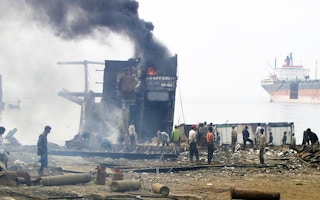People living in South Asia could lose about five years of their lives on average unless air quality improves to WHO-prescribed levels, according to a new assessment.
Released Tuesday by the University of Chicago’s Energy Policy Institute, the Air Quality Life Index (AQLI) report for 2022 says that air pollution is the biggest threat to human life globally. The Index finds that particulate air pollution takes 2.2 years off global average life expectancy comparable to that of smoking, and far exceeding that of alcohol use, unsafe water, HIV/AIDS and terrorism.
Despite ambitious schemes to control aerial pollutants, some 510 million residents of the Indo-Gangetic plains of northern India stand to lose as much as 7.6 years of life expectancy, if the current high levels of pollution persist, according to a media release on the report.
The title of the world’s most polluted country now falls to Bangladesh where air pollution shortens average life expectancy by 6.7 years with the most polluted districts showing lives shortened by 8.1 years. All of Bangladesh’s 161 million people live in areas where the annual average particulate pollution level exceeds the WHO ideal as well as the country’s own national standard.
While the air over Bangladesh is 15 times worse than the WHO standard, two other countries along the Indo-Gangetic plains, Nepal and Pakistan, have air quality that is nine times worse than the WHO-prescribed safe limit of five micrograms per cubic metre.
Air quality scientists like Bhupendra Das, director of Nepal Energy and Environment Development Services, Kathmandu, lays the blame on the increase in all kinds of combustion in the region as part of development.
“
Delhi shut down coal-fired power plants, banned dirty fuels, scaled-up use of natural gas for industry and for public transport but the ever-worsening situation shows that the time has come for even more difficult and inconvenient solutions.
Anumita Roy Chowdhury, executive director of research and advocacy, Centre for Science and Environment
“The rapid increase in combustion technology [such as in transport], open burning sources [such as agricultural fields and forests] … and trans-boundary air pollution, are all contributing to the rise in air pollution in South Asia,” says Das.
Residents of India’s Delhi stand to gain 10 years of life expectancy if levels of PM 2.5 (particulate matter smaller than 2.5 microns) are brought down to the five micrograms per cubic metre target.
“The latest Air Quality Life Index sends out an important policy message that if we, in the Indo-Gangetic plains, including northern India and the adjacent countries, clean up the air we will live longer and improve overall wellbeing and productivity,” said Anumita Roy Chowdhury, executive director of research and advocacy at the Centre for Science and Environment, New Delhi.
In 2019, the Indian government launched the ambitious National Clean Air Programme, to improve air quality in over 100 cities across the country, but three years down the line the situation in Delhi and most other cities appears to have only worsened. Since 2013, according to the AQLI, about 44 per cent of the world’s increase in pollution has come from India.
“Delhi shut down coal-fired power plants, banned dirty fuels, scaled-up use of natural gas for industry and for public transport but the ever-worsening situation shows that the time has come for even more difficult and inconvenient solutions,” explained Roy Chowdhury.
Michael Greenstone, creator of the Air Quality Life Index and director of the Energy Policy Institute, said strong policies, “supported by an equally strong willingness for change”, had successfully reduced air pollution in many countries, such as the US.
According to the report, despite the pandemic lockdowns, there was barely any improvement in pollution levels during the first year of the Covid-19 pandemic, underscoring the long-term persistent health threats.
Almost all of Southeast Asia is now considered to have unsafe levels of pollution. Residents living in the most polluted parts and in the surrounding cities of Mandalay, Hanoi and Jakarta are expected to lose three to four years of life expectancy on average.
Similarly, almost all of Central and West Africa are considered unsafe, with those living in the most polluted areas expected to see their lives shorten by an average of five years.
China, among the top five most polluted countries for the last two decades, has reduced its PM 2.5 pollution by 28 per cent so that its people can expect to live 1.4 years longer, according to the AQLI. The Beijing-Tianjin-Hebei area saw a 33 per cent reduction in pollution, translating into a gain of 2.6 years of life expectancy for some 109 million residents.
Despite the significant improvements, China still ranks as the world’s tenth most polluted country assessed by AQLI.
This article was originally published on SciDev.Net. Read the original article.










